 Elderly patients with hip fractures better treated at smaller health facilities.
Elderly patients with hip fractures better treated at smaller health facilities.Transthoracic echocardiogram (TTE) may prolong the time to surgery (TTS) in older adults with hip fractures, a recent study has found.
Researchers conducted a retrospective review of 1,079 older adults (mean age, 84.2 years; 75 percent female) with hip fractures. Electronic medical records were accessed for relevant data such as TTS, length of stay, in-hospital mortality, and noninvasive preoperative cardiac testing, including pharmacological stress tests or TTE.
A total of 370 patients underwent TTE. These participants experienced a significantly longer median TTS than their counterparts who had not received the preoperative cardiac testing (1.55 vs 1.02 days; p<0.01). In addition, median length of stay was also marginally longer (5.78 vs 5.08; p=0.62).
Multivariable extended Cox regression analysis suggested that TTE performed early on in admission may not cause substantial delays to TTS, but such an effect may be expected if TTE is performed later. Comorbidities likewise appeared to prolong TTS, while admission into a tertiary hospital (as opposed to a community care centre) shortened TTS.
In comparison, preoperative TTE did not seem to significantly affect length of hospital stay after surgery (p=0.65), while postoperative TTE did (p<0.001). TTS was likewise correlated with length of stay (p=0.01).
There were 32 deaths following hip repair, yielding an in-hospital mortality rate of 32 percent. This was not statistically related to TTE (p=0.7). In contrast, stay in the intensive care unit (p<0.001) and in the cardiac care unit (p=0.042) both emerged as significant correlates of mortality.
“Given the association between TTE and longer TTS, further studies must clarify the role of preoperative TTE in this population,” researchers said.